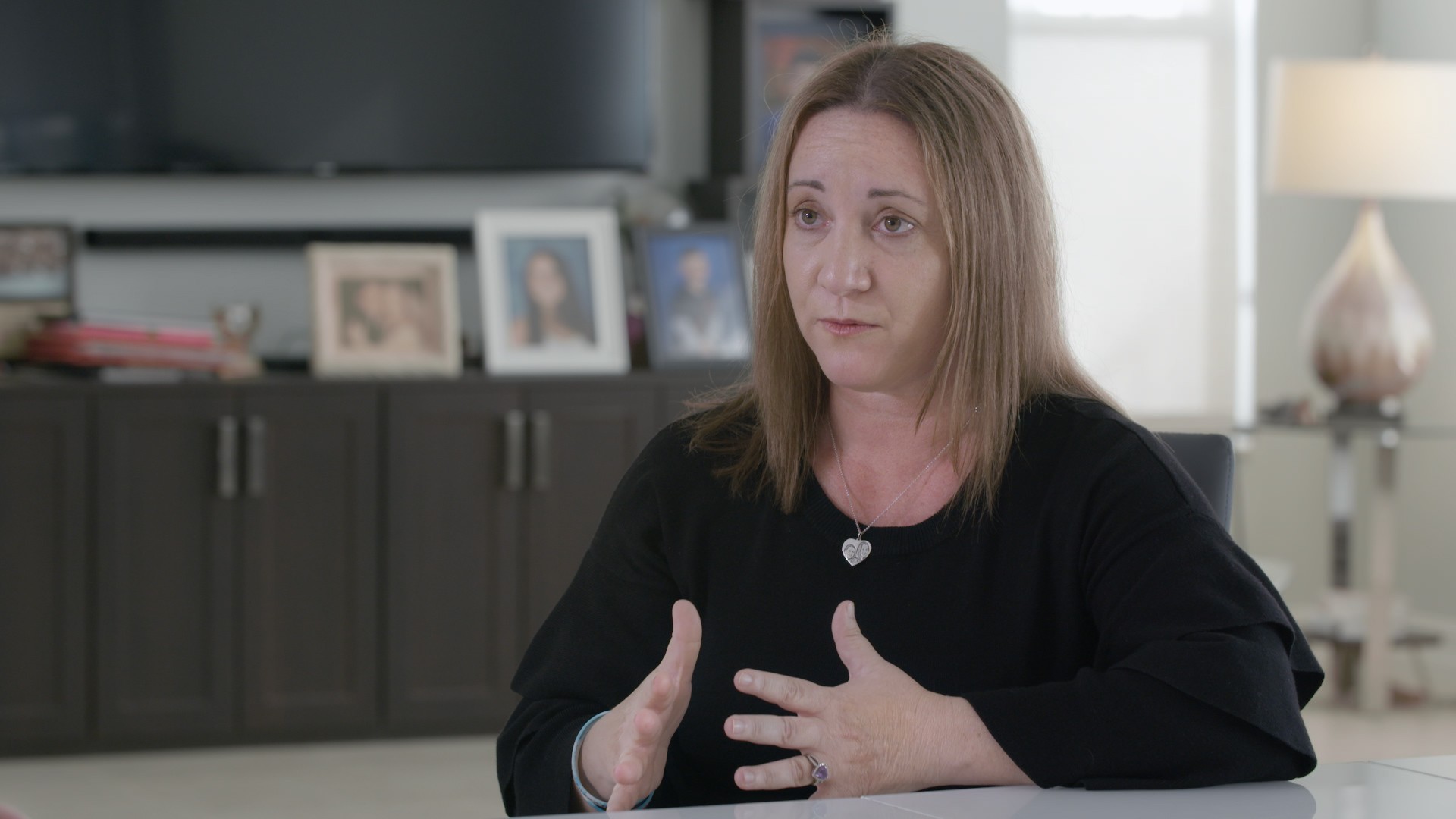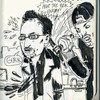Photo of students on a school bus by Ricky Carioti/The Washington Post via Getty
As parents, teachers, and students settle back into the familiar rhythms of a school year, one organization wants to remind everyone that at any time, a school campus could become a war zone. And one way to help prevent mass shootings, it suggests, is for children to constantly monitor their peers for any signs of nonconformity.Sandy Hook Promise is a nonprofit led by family members of victims of the 2012 Sandy Hook Elementary School shooting, the horrific massacre that has come to represent one of the most primal fears in America today: that someone could come to your child's school with a gun and start shooting. Unlike many gun-control organizations, SHP is narrowly focused on school shootings, and unafraid to use visceral messages. This week, it debuted a PSA that showed kids talking about their "back to school essentials" while they fled a school shooter, hid in a classroom, and applied a tourniquet to a classmate bleeding profusely from their leg."It's meant to be an intense video," Nicole Hockley, the SHP managing director, told CNN. "This is what our kids are experiencing now in school."The actions SHP suggests to fight gun violence in schools include a slate of relatively moderate gun control policies like expanded background checks. It also has programs individual schools can implement, like "Start With Hello," which encourages students to reach out to isolated peers. But what caught the eye of Twitter users on Thursday morning was another program, called "Say Something." According to the SHP website, Say Something "teaches students, grades 6-12, how to look for warning signs, signals and threats, especially in social media, of an individual who may be a threat to themselves or others and to say something to a trusted adult to get help." What warning signs? SHP has a list that included genuine criminal activity, like bringing weapons to school and planning attacks, but also more mundane behaviors, like "significant personality changes" and "hanging out with negative role models."Aimee Thunberg, the communications director for SHP, defended the list, which she emphasized is meant to be used in conjunction with free training given to schools. "This list is based on years of research with psychologists, threat assessment professionals—particularly the research of Dr. Dewey Cornell and Dr. Reid Malloy, and law enforcement—including the FBI, as well as CDC research on violence and gun violence," Thunberg said. "It’s also based on nearly every mass shooting report in the U.S., including Sandy Hook Elementary where signs were missed about the shooter." She added that the list isn't just about identifying someone at risk of gun violence but also other crises like abuse or suicide. "When we see several signs being exhibited by an individual, someone should check in on the person to see if they need help."Joel Dvoskin, a clinical and forensic psychologist who was a member of the American Psychological Association Task Force on Reducing Gun Violence, said that as long as the school administrators who received reports from students were properly trained not to overreact to accounts of a supposedly troubled kid, there wasn't much risk in a program like Say Something. But he added that checklists weren't an ideal way to identify potential shooters, because they would produce too many false positives—a lot of people, and a lot of teens in particular, are alienated or depressed. A better rule of thumb, he told VICE, was to tell kids to talk to an adult "if you’re scared of someone, or if you’re scared for someone."But the checklist also points to the larger conversation about school shootings and their place in the never-ending debate over guns. "School safety" is sometimes a smokescreen used by conservatives to avoid talking about gun control—to the point where a Florida commission formed in the wake of the Parkland shooting recommended putting more guns in schools. The idea, pushed by SHP and others, that school shootings are an epidemic has fueled the militarization of U.S. schools, as armed guards, mass shooting drills, and calls for armed teachers become increasingly common.

All of this—the trainings, the alarm, the PSAs that emphasize the trauma of school shootings—elides the fact that school shootings are much more rare than other kinds of gun violence. "EACH DAY 8 children die from gun violence in America. Another 32 are shot and injured," reads an online fact sheet from SHP, which goes on to note, "The U.S. has had 1,316 school shootings since 1970 and these numbers are increasing. 18% of school shootings have taken place since the tragedy at Sandy Hook Elementary School in December 2012."But the connection between the number of kids who die every day and the increase in school shootings isn't particularly strong. As the article SHP links to explains, while a majority of child and teen gun deaths are homicides, school shootings "remain the smallest proportion of deaths, accounting for 1.2% of all homicides among 5 to 18-year-olds."Statistics like that are why some gun control advocates now say that the emphasis on mass shootings could be a mistake: When society focuses on preventing rare but extremely deadly events, it may overreact to certain kinds of violence while underrating the effect of everyday violence like gun suicides, which remain one of the most pressing gun-related public health concerns.The question of what to do when a teenager is visibly struggling and prone to lashing out is a tough one. But if the debate is over how to stop that teen from becoming a mass killer, the answer seems easier: Make it harder for them to acquire guns. The problem isn't exactly that kids are disturbed, the problem is that disturbed people of all ages can too easily become killers.Sign up for our newsletter to get the best of VICE delivered to your inbox daily.Follow Harry Cheadle on Twitter.
Advertisement
As this list spread online, people were extremely skeptical of not just the idea that the way to prevent mass shootings was to turn schoolchildren into informants, but the way that the checklist appeared to blur the lines between ordinary teenage behavior and markers of a potential murderer. "So many of these red flags, from changes in 'personal appearance' to 'sleeping habits,' are *entirely normal* for growing children," tweeted Patrick Blanchfield, an academic who has written about guns and violence.
Advertisement
Advertisement

All of this—the trainings, the alarm, the PSAs that emphasize the trauma of school shootings—elides the fact that school shootings are much more rare than other kinds of gun violence. "EACH DAY 8 children die from gun violence in America. Another 32 are shot and injured," reads an online fact sheet from SHP, which goes on to note, "The U.S. has had 1,316 school shootings since 1970 and these numbers are increasing. 18% of school shootings have taken place since the tragedy at Sandy Hook Elementary School in December 2012."But the connection between the number of kids who die every day and the increase in school shootings isn't particularly strong. As the article SHP links to explains, while a majority of child and teen gun deaths are homicides, school shootings "remain the smallest proportion of deaths, accounting for 1.2% of all homicides among 5 to 18-year-olds."Statistics like that are why some gun control advocates now say that the emphasis on mass shootings could be a mistake: When society focuses on preventing rare but extremely deadly events, it may overreact to certain kinds of violence while underrating the effect of everyday violence like gun suicides, which remain one of the most pressing gun-related public health concerns.The question of what to do when a teenager is visibly struggling and prone to lashing out is a tough one. But if the debate is over how to stop that teen from becoming a mass killer, the answer seems easier: Make it harder for them to acquire guns. The problem isn't exactly that kids are disturbed, the problem is that disturbed people of all ages can too easily become killers.Sign up for our newsletter to get the best of VICE delivered to your inbox daily.Follow Harry Cheadle on Twitter.
